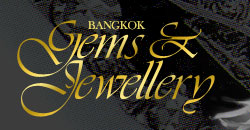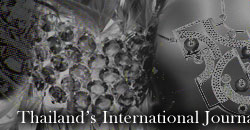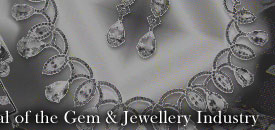 |
 |
 |
 |
Old
issues |
Vol.
18 No. 5 -- December 2004 |
||
 |
||||
| Synthetic diamonds have been quite a bit in the news lately, and why not? With the difficulty to distinguish between the natural and the manmade that was initially giving the diamond trade ,not to mention De Beers,sleepless nights,the industry probably thought that it had its hands full with Apollo and Gemesis. However,it has recently comt to light that the Russains are busy bettering the technology that they sold to Gemesis, guaranteeing a further nightmare for the industry.Walther Barshai reports on the latest in Russian diamond synthesizing technology. |
|
| THE ART OF CULTURING PEARLS |
| A Delicate Operation With Uncertain Results |
There is a rather pathetic joke that
asks, "How do you culture a pearl, sing to it? No, Irritate it!"
As jokes go, this one is truly pathetic but
A.Opening an oyster to find a perfect pearl.If all goes
well with the culturing process there is a 5% chance that the resulting
pearl will be a perfect specimen.
C.Freshwater mussels can yeild more than one
pearl at a time and they can be reused again. |
|
wooden wedge or speculum is inserted between the valves to keep the
animal from closing them.
F.Examining and cleaning the
oysters from time is neccessary to prevent disease. |
are lifted out from the sea for cleaning and health treatments. Seaweed,
barnacles and other undersea growths that might impede their feeding
are removed from the shells which are then treated with medicinal
compounds to prevent parasites from hurting the oysters in any way.
i. Assorting pearls by size,shape,colour,and luster.It may take as many as 10,000 pearls pearls to yeild enough matching pearls make a single necklace. by inserting the irritant that forms the core of the pearl, nevertheless after this preliminary interference, everything else is left to the whims of nature. Therefore even cultured pearls are real jewels.Like natural pearls, no two cultured pearls are ever identical. Therefore sorting pearls calls for refined skills that blend similar looking pearls together so that they match. When it comes to drilling, a great deal of care and precision is required as a hole drilled even fractionally of centre can rum the pearl for use in a necklace or jewel that depends upon the symmetrical assembly of its pearls. Because no two cultured pearls are alike, assorters go through about ten thousand pearls before they find enough similar to make a single necklace. Therefore cultured pearls are truly precious and here it is pertinent to point out that all marine pearls in the market today, be they akoya. South Sea, Tahitian or mabe, they are all cultured and cultivated on pearl farms.
|
C
o p y r i g h t © 2 0 0 0 - 2 0 1 6 D4U
WEB TM A l l R
i g h t s R e s e r v e d |